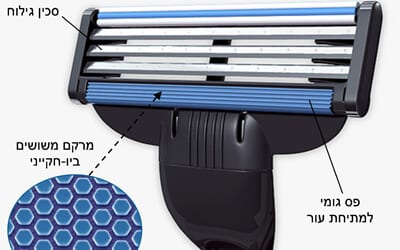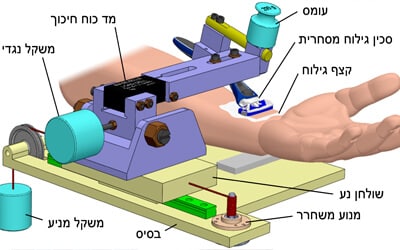The Technion researchers found a way to significantly improve the shaving process, following a friction test of surfaces that imitate surface textures developed in the legs of a frog, cricket and salamander.


The Technion researchers found a way to significantly improve the shaving process, following a friction test of surfaces that imitate surface textures developed in the legs of a frog, cricket and salamander.
The group of researchers, led by associate professor Michael Warenberg, head of the tribology laboratories in the Faculty of Mechanical Engineering, examined how the frog, the salamander and the cricket, which exist in a wet environment, do not slip on wet surfaces. The surfaces that imitate biological textures were tested with the help of a unique facility of its kind in the world built by Prof. Warenberg's research group. This device is able to measure forces that develop between surfaces in contact, such as friction and adhesion, while working inside a scanning electron microscope. This allows at the same time to see in high resolution how the surfaces in contact behave. "We use nature's solutions as a source of inspiration for the development of new surface engineering technologies," explains Prof. Verenberg.
"We do this in collaboration with biologists who provide us with information about the functions and complex structure of biological systems which we try to simplify and apply through technical means. This process also makes it possible to understand how things work in nature and to advance engineering."
The researchers found that the animals that exist in a wet environment improve their grip by removing liquid from the contact with the help of special channels that exist in the contact surfaces of their feet. It turned out that a similar problem also exists in modern razors. The rubber band under the blades is designed to increase friction to stretch the skin before the blades go over it for a better shave. The presence of shaving foam on the skin reduces the friction and therefore interferes with the stretching of the skin. To test real razors, the researchers removed the razors and replaced the original rubber band, which today carries a series of small wipers (Figure 1), with a rubber band with a biomimetic hexagonal texture that they built after examining the legs of the frog, cricket and salamander. "The surface we produced in the laboratory is twice as effective in increasing the friction with the skin in the presence of shaving foam than the surface found in commercial knives," explains Prof. Wernberg, who filed a patent for the discovery together with his student, Alexei Tsypaniuk. "Our surface is also more pleasant in contact with the skin," adds Alexey, who performed friction measurement experiments on the skin of his hand (Figure 2). Alexey's poster was recently selected as one of the three best posters in a competition held at the Russell Berry Nanotechnology Institute (RBNI).
The article describing the work was published in the Interface newspaper of the Royal Society of London for the Advancement of Knowledge in the Natural Sciences. It can be found at

5 תגובות
"Someone", the order of magnitude of human hairs are micrometers. That is, millions of meters. Nano means 10 times smaller than that. That is, one billionth of a meter. It seems to me that small robots that can shave faces will be at least as big as a louse and will not come as ointment but will come out of a small box that will be connected to the Google glasses...
I'm still waiting for an ointment that contains tiny nano-robots, which you apply to your face and within seconds it removes and cleans the bristles (the nano-robots identify the bristles and cut them from the base), rinse with water and get a perfectly smooth face.
I was amazed at the mistakes
They invented a device to test shaving on the only part of the body where hair does not grow: the inside of the hand
What's more, the skin on the face of the hand has physical properties opposite to the skin on the face
In fact, these are the two types of skin on the body that present opposite extremes in terms of softness, thickness, level of elasticity, and internal and external structure.
The invention combines two opposite ends: a deep understanding of science and a lack of basic thought.
I would design a device that would work on the skin of the face but then it would no longer be a patent because the idea was brought up here before and it's a shame.
"Adhesion": the force of attraction between the molecules of two different substances.
Do not rush to sell rights to use the patent,
Take out an excellent razor,
That's where the big money is!!!